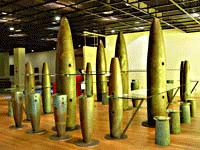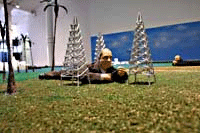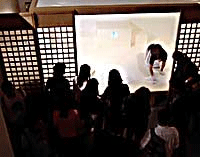An Eastern art show to rival Venice
September 29, 2004
Gwangju Biennale presents over 200 contemporary artists
By KATE THOMSON
Special to the Japan Times
On May 18, 1980, the city of Gwangju, South Korea, hit the headlines with an explosion of civilian dissent against the military junta that had seized power the day before. The junta's brutal crackdown culminated in the Gwangju Massacre of hundreds of students and civilians. The uprising would spark South Korea's democracy movement, and ultimately the overthrow of the military dictatorship and the installation of its first civilian-led government in 1993.



The Gwangju Biennale was established in 1995 as an international contemporary art festival to revitalize cultural life after years of political and economical crisis.
Rather than mimicking the predictable format of the likes of the Venice Biennale, the organizers wanted to celebrate and extend the spirit of Gwangju's democracy movement. At the opening of this year's Gwangju Biennale on Sept. 10, South Korean President Roh Moo Hyun declared Gwangju as the country's "cultural capital," officially acknowledging the city's political and artistic importance.
In the exhibtion titled "And Others -- minority" at the 18 May Liberty Park, the former military police barracks and cells used in the 1980s for detaining and torturing dissidents are preserved as a memorial to the uprising.
For this exhibition they are now being used as a series of galleries for teams of young Korean artists, addressing everything from the Gwangju Massacre to the rampant development of the surrounding area at the expense of environmental preservation.
Passionate as these works are, they often fall short of making an impact. Collages of images in several of the installations are in danger of popularizing superficial stereotypes by mimicking mass media as much as criticizing it. But as curator Hee Seung Jung writes in the exhibition catalog, "Artists are motivated by the vivid memory of the past, but their imaginations strive for new ways of seeing. Memory is a mirror that reflects our present; imagination a stammering toward our future."
A desire for new development in art that incites debates about society is the most admirable unifying theme of the Gwangju Biennale. This year's theme, "A Grain of Dust, A Drop of Water," represents the relationships that form the basis for ecological harmony. Artistic Director Lee Yong Woo said, "They [dust and water] are not just simple materials but a spirit and a discourse."
For the first time, the organizers have decided to hold a "viewer-participant" experiment, initiating collaboration between the viewers and makers of art.
Sixty viewer-participants were selected from around the world according to demographic data (provided by cultural, social, human rights and government groups, as well as the CIA). The selected participants then chose more than 200 artists from 41 countries with the help of the three artistic directors and five curators. The hope was that these pairings would result in unique new works. "There are 200 biennales in the world, so it was important to find an individual identity for Gwangju," Biennale President Kim Po Chun said.
Despite the huge diversity of viewer-participants (which included farmers, scientists, students, etc.), Artistic Director Kerry Brougher said the results far exceeded expectations. "All the organizers I met in Gwangju came up with the same figure: 60 percent successful partnerships and only 10 percent "divorce."
Interpretations of the theme were naturally as varied as they were unpredictable, but had a strong emphasis on social, human rights and environmental issues.
Most pairs had the same nationality and spoke the same language, though they often came from different cultural or social backgrounds.
Korean women's rights activist In Soon Nam and artist Jin Ran Kim shared similar thoughts about the persistence of discrimination against women. Their exhibit was a fascinatingly gentle feminist performance titiled "Exercise in Futility," in which the artist washes a floor made of soap.
American viewer-participant Richard Rhodes, who won the Pulitzer Prize for his book "The Making of the Atomic Bomb," selected American artist Jim Sanborn. From 1998 to 2003, Sanborn read and reread Rhodes' books while collecting antique electronics from Los Alamos National Laboratory in New Mexico to re-create the setting for the United States' development of the first atomic bomb.
In Sanborn's "Critical Assembly" installation, Geiger counters click ominously (in reaction to benign radium dial clocks set next to them). My instinctive reaction was to get out of there as quickly as possible. Sanborn told me, in conversation, that my reaction might well have been justified as this equipment could be used to construct an atomic bomb if a few grams of weapons-grade uranium were added. He said his work is about disclosure. "These materials aren't well enough protected," he said. "They're far too easily available. It is important that people know what these objects look like so that in the future dangerous materials are more protected."
Given the current high-security climate on the peninsula, it's incredible that the artist managed to bring all of these materials into Korea.
A different perspective on disclosure of information evolved in the collaboration between the Nigerian-based Ghanaian artist El Anatsui and Solomon Obeng, the coordinating officer for Free Learning and Merit Education (FLAME) in Ghana.
The large sculptures made from recycled newspaper printing plates, hammered literally by hand, touches on issues of the environment, poverty, access to education and ways of righting our past wrongs that Obeng, and many other participants, felt were of greatest public interest. . Anatsui said, "Wouldn't it be incredible if we could also recycle all the knowledge and ideas contained here which were thrown away after being read only once?"
Another work that sprung out of the desire to inform deservedly won the The Gwangju Biennale Best Team Award. Peruvian artist Jota Castro was so impressed by British campaigner for overseas development, Peter Moszynki that he decided to present the life and work of this viewer-participant as his work of art. "A Drop in the Ocean" takes the form of a newspaper that reports, in harrowing detail, the desperate plight of the persecuted indigenous population in southern Sudan, which is Moszynki's field. As the cover states, "This publication is not just a collaboration between two people. It is proof that art can develop anywhere and that artist and viewer have to take risks together. It is also a tribute to those who are trying to improve the world we all live in."
All viewers are invited to participate by taking a copy.
Several e-mail dialogues that document the methods and degrees of collaboration are published in the biennale catalog. In some cases, this is more evidence of a response to existing work as opposed to a true collaboration between viewer-participant and artist. Japanese architect Kengo Kuma used the opportunity to praise the work of his fellow countrywoman, Momoyo Torimitsu. She humorously conveyed a message about global power struggles in videos of Asian and American life-size robot "enterprise soldiers" creeping through an American office and her miniature installation of business-suited GI dolls battling it out over oil rigs and real estate.
The EcoMetro project takes the project one stage further by confronting the public with art that transforms their everyday environment. Using the Geumnamro 4-ga (train) station as a site, Korean and international artists use photographs to replace windows on one train, which has resin handgrips, embroidered floor cushions and sculptures functioning as the seats. Irish artist Jim Buckley's lighting installations transformed the color and atmosphere throughout the station and the train.
Buckley was impressed with the way that the project made the artists accessible to a wider audience and garnered strong public interest. He had strong reservations about the intentions of the organizers, "The viewer-participant system was a political game being played with artists and the public, there was scant evidence of real collaboration with the viewers," he said.
After taking in so many different views on the relationship between the artists and the public, it was a relief to sit down and have a drink with some of the artists and visitors in "The Club" area, where the central bar and stools are also an artwork. Ok-san Lim's "Communication Cafe" in the "The Club Area" is made from bombshells collected from the Maehyang-Li site, where villagers were killed by U.S. soldiers during the Korean War.
"The Club" also functions as a hub for performance works, public talks and discussions, as well as an exhibition space. One artist showing here, Min Jung Kim, who was born in Gwangju and lives in Milan, Italy. She was amazed at the changes in Gwangju City since she left after high school. "[There's] too much concrete, but people are more free to talk," she said. In her work "Changing Mind and Matter" she repeatedly burned papers, pasting the remains together to form flowers symbolizing a circular path that transforms the suffering and frustration of the tumultuous 1980s she experienced in Gwangju into an optimistic harmony.
Expectations were high for Gwangju Biennale's ambitious experiment. Although some of the works lacked artistic depth, and it is unclear how much real collaboration there was, the event was clearly a dynamic meeting place, providing an atmosphere of fun as well as raising pertinent questions about the interaction between the arts and society.
Gwangju Biennale runs until Nov. 13. For further information go to the English Web site at www.gwangju-biennale.org; to discuss this article go to www.ukishima.net
The Japan Times: Sept. 29, 2004
(C) All rights reserved